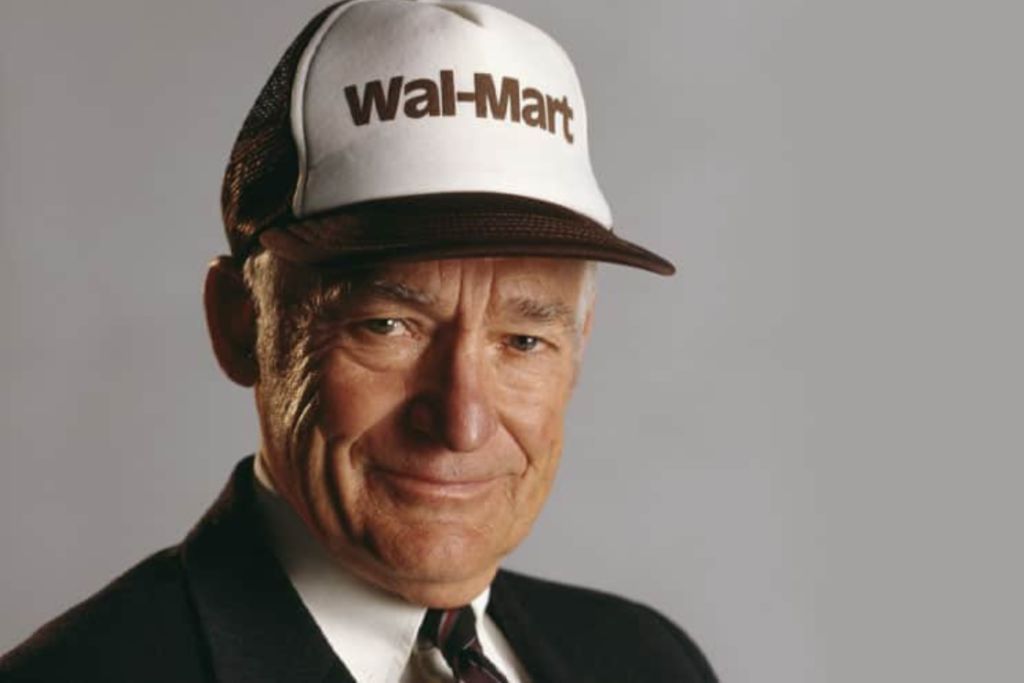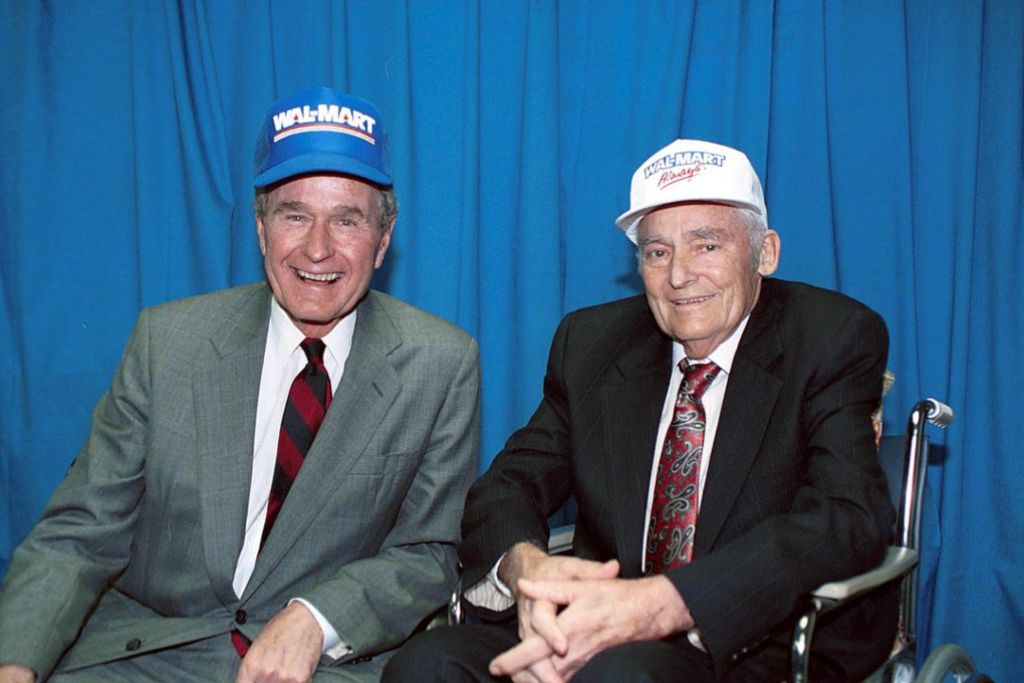
Today, Walmart is the world’s second largest supermarket chain, with the controlling Walton family being among the richest families in the world. This is all thanks to one man – Sam Walton – the founder of Walmart.
Going from humble beginnings, Sam Walton would soon establish a supermarket empire that is within 10 miles of almost 90% of Americans, which soon made Sam Walton the world’s richest man, from 1982 until 1988!
Early Life
Born on March 29 1918 to farmers Thomas Gibson Walton and Nancy Lee Walton in Kingfisher, Oklahoma, Samuel Moore Walton would be oldest of two sons (with his little brother Bud, being born on December 20 1920).
Despite their best efforts, the Walton farm would be unsuccessful, owing to the highly competitive farming market that sprung up in the years following WWI (thus paving the way for the Roaring Twenties).
Seeing this, in 1923, the Waltons would close and sell off their farm, move to Missouri, and open a farm mortgaging business (that would later become an agent for MetLife Insurance), providing mortgages to people looking to establish their own farm.
For the most part, the family was quite prosperous, soon becoming one of the largest farm mortgaging companies in the state of Missouri. However, in 1929, the stock market would crash, setting off the devastating Great Depression.
The Great Depression would see many farms go out of business, with the Walton family soon finding it difficult to make ends meet, resulting in the two Walton sons, Sam and Bud, being put to work.
In the beginning, an eleven year-old Sam would milk the family cow, selling the excess milk to customers in town. Eventually, Sam began delivering the Columbia Daily Tribune newspaper, and selling magazine subscriptions door-to-door.
Despite working hard to help support his family, Sam Walton would excel at school.
On top of getting good grades, Sam would also make the high school football team, whilst also being the first person in the town of Shelbina (where he lived at the time) to become an Eagle Scout.
Life in The Military
Graduating high school in 1937, Sam chose to enroll at the University of Missouri, before joining the Reserve Officers’ Training Corps (ROTC) on campus.
As a member of the ROTC, the military would cover Sam’s tuition. Only needing to pay for his meals, Sam would work as a waiter, with part of his wage being paid in the form of free meals.
Sam Walton would graduate in 1940 with a bachelor’s degree in economics, being voted as the class president.
Three days after graduating, Sam would gain a place on a J. C. Penny management course in Des Moines, Iowa.
Quickly making his way through the course, Sam would soon become a manager at a J. C. Penny location, earning $75 a month ($1,451 per month in today’s money).
Spending the next 18 months there, Sam would learn much about the retail industry (that he’d later use for his own companies!)
Following Imperial Japan’s attack on the US Pacific fleet at Pearl Harbor, and the US’s formal entry into WWII, Sam Walton would resign from J. C. Penny, anticipating that his time in the ROTC would see the US military enlist his help.
Not happening as immediately as he’d thought it would, Sam would find work at a DuPont munitions plant in Tulsa, Oklahoma.
Soon after taking this job, the US Army would recruit him, with Sam choosing to join the US Army Intelligence Corps as an officer.
Here, his management experience at J. C. Penny would see a young Sam be sent to Fort Douglas in Utah, where he’d oversee security at prisoner of war (POW) camps and aircraft plants across the country.
Whilst still in the Army, Sam would meet Helen Robson at the bowling alley her dad used to take her to. On February 14 1943, the pair would marry, vowing to avoid family squabbles at all cost (which would help make the Waltons the richest family in America).
Leaving the army in 1945, Sam would already be a father of one (with Rob Walton being born in 1944), with another on the way. Upon leaving, Sam would’ve achieved the rank of captain.
Getting a Start
During his time in the army, Sam Walton had made sure to save a large part of his income. By the time he left, Sam’s savings totaled $5,000 ($74,000 in today’s money).
Using this money, coupled with a $20,000 loan ($297,000 in today’s money) from his father-in-law (a rich Oklahoman banker), Sam Walton would move to Newport, Arkansas and buy a Ben Franklin franchise (a type of five-and-dime store prevalent in small American towns at the time).
Setting up in Newport, Sam soon realized that if he wanted to attract more customers to his store, he needed to offer prices that made it cheaper for people to walk to his store, rather than drive several miles to the supermarket.
As you can probably imagine, the residents of Newport soon began to notice this, and began flocking to Sam’s store en masse. In his first year of business, Sam’s five-and-dime store had a turnover of $80,000 (roughly $1.2 million today).
Within his third year, Sam’s store had growth to have a $225,000 turnover (roughly $2.5 million today), soon becoming one of the largest stores in Newport. Indeed, this incredible growth allowed Sam to set up a smaller store right next to his main competitor!
However, this success would not go unnoticed.
You see, in 1945, Sam Walton had negotiated a five-year lease on his building from landlord P. K. Holmes, which was nearly up in 1949. Seeing this, and his family’s long history in the retail business, P. K. Holmes tried to force a sale.
When Sam refused, Holmes refused to renew the lease, in the hopes of forcing a sale. Despite essentially forcing Sam out, Holmes did pay $50,000 for the store’s inventory and fixtures, something Sam would later describe as a “fair price”.
Starting Again

Having been forced out of his first business, Sam Walton was determined to start again, this time in a different city all together. The city he chose was Bentonville, Arkansas, on the other side of the state.
Together with his wife and father-in-law, Sam would negotiate the purchase of a store in a prime location in the heart of Bentonville.
Learning his mistake from last time, Sam would refuse to sign the lease unless it would last for 99 years, and gave him the ability to expand into the store next door (which was then-occupied by another store) if he ever wanted to.
Prior to Walton’s acquisition of the Bentonville store, it had been turning over $72,000. Following his acquisition, Sam implemented the policies he’d pioneered in Newport, increasing turnover to $105,000 within the first year of owning it.
This success allowed Sam to expand into the store next door (much to the store owner’s dismay), giving him ownership of the store in Newport (which he still technically owned, although didn’t run, at the time) and the one in Bentonville.
Seeing the success of his two stores, separated by 220 miles, Sam hired his brother Bud and began scouting new locations across Arkansas.
Sick of driving up and down the state, and Bud being a former naval aviator during the war, the brothers would purchase an old, second-hand aircraft to scout new locations.
By 1962, the brothers owned 16 stores, 15 of which were Ben Franklin stores and one of which was independent.
Starting Walmart
Owning the most profitable franchise stores, Sam tried to convince the Ben Franklin management that the best way to thrive, was to focus specifically on rural communities. However, Ben Franklin management told him to stick to operating the tills.
Angry with the immense disrespect he was shown, Sam decided then and there to go at it alone.
Having the experience, but not the money to establish his own supermarket chain, Sam Walton would turn to Herbert Gibson, the head of Gibson’s Discount Stores (a large discount chain in the south), looking to form a partnership in 1961.
Due to Sam Walton’s lack of capital, Gibson laughed Walton off, claiming that helping him start a business would be too risky.
Eventually gathering enough capital, Sam would move to the nearby city of Rogers, Arkansas. Here, he would establish what he called the Wal-Mart Discount City store, which would prove to be the first true Walmart as we know them today.
Not being a franchisee have Sam the ability to focus on giving customers the lowest possible prices, by focusing on American-made goods that could be bought by the company for pennies, before being distributed to the various regional warehouses.
Sam would make sure that these warehouses essentially operated as forward operating bases, with all original Wal-Mart locations being within a day’s drive from at least one Wal-Mart warehouse.
By focusing on small towns, rather than large cities as the practice for discount stores at the time, Sam would effectively gain monopolies over these small towns, as brand loyalty soon formed in the area, much to many politicians’ annoyance.
Expanding Walmart
Not surprisingly, Wal-Mart would do quite well, with the first store soon becoming one of the largest stores in Bentonville. Building on this success, Sam would set up a second store in the city of Harrison, Arkansas, about an hour away from Bentonville.
However, adding this new store revealed one major issue for Sam Walton – the name of his store was too long.
Whilst describing what the company did extremely well, it was too long to advertize with. To that end, Sam Walton’s personal secretary, Bob Bogle, would coin the term “Wal-Mart” which the company would use until 2018, when it became “Walmart”.
By 1967, Wal-Mart was the largest statewide supermarket chain in Arkansas, with 27 locations and $12.6 million in revenue. The following year would also see the company expand out of state, first setting up shop in Sikeston, Missouri and later Claremore, Oklahoma.
Over the course of the 1970’s and 1980’s, Sam Walton would pioneer the expansion of the company, going from 29 locations in 1968, to 190 stores in 1977, and later, 800 stores in 1985.
To raise finance for this, Sam would lead Walmart as it had its IPO on October 1 1970, where its stock was valued at $16.50 per share, increasing Sam Walton’s net worth several fold.
Hoping to increase the company’s revenue, whilst minimizing risk, Sam Walton would pioneer half-corporate owned, half-manager owned Walmart stores, which would give the managers a financial incentive to innovate and reduce costs.
Even as the company became one of the largest on the planet, Sam Walton was famous for just dropping into a local Walmart to see how things were being run, talking to employees, whilst posing as a regular customer.
This is where Walmart would develop many of its best techniques, such as the cardboard cutout man at the main entrance to dissuade shoplifters.
Indeed, Sam found out when he dropped in to one of his stores, to find a young man doing this job personally! Realizing he’d be more useful elsewhere, Sam had all of his stores buy cardboard cutouts, which were even more effective than the physical person!
Sam’s Club
In 1983, as a part of Walmart’s expansion, Sam Walton began to notice that companies like Costco and BJ’s Wholesale Club were beginning to take away much of Walmart’s customers, especially those in poorer neighborhoods.
To compete with them, whilst not totally rebuilding the already established Walmart brand, Sam would lead the campaign to establish a Walmart subsidiary that had a very similar business model to Costco/BJ’s.
In honor of the man who founded Walmart, who had also helped to establish Walmart’s competitor to Costco and BJ’s, Walmart executives floated the idea of calling this new retailer, Sam’s Club.
Agreeing to the name, Sam Walton would personally open the first Sam’s Club location, in Midwest City, Oklahoma, on April 7 1983.
Proving to be more aggressive than Costco and BJ’s (in many ways), Sam’s Club would expand rapidly, with Sam soon negotiating the acquisition of Louisiana-based SuperSaver Wholesale Warehouse Club from Alton and John Howard, giving them an extra 24 stores.
Two years later, Sam would oversee Sam’s Club opening a store in New Jersey, which would mark Walmart’s first expansion into the northeast.
In 1993, Sam would lead Walmart’s acquisition of PACE Membership Warehouse, from rival Kmart, with most former PACE locations being converted into Sam’s Club locations (although the largest few would become standard Walmart locations).
Death
In 1982, Forbes officially declared Sam Walton as being the richest man in the world. Whilst you’d expect this to have pleased Sam, it was wholly the other way around. He hated it.
For much of his business career, Sam had kept a rather low-profile, even by today’s standards. Yet, Forbes telling the world who he was quite annoyed him, with thousands of people coming to his Bentonville store just to meet him.
Gving a rare interview in 1985, Sam would even go as far to say:
“All that hullabaloo about somebody’s net worth is just stupid, and it’s made my life a lot more complex and difficult”
In the early 1990’s, Sam Walton was diagnosed with two separate forms of cancer. The first, was hairy-root leukemia, whilst the second was bone marrow cancer, which vastly reduced his ability to work on Wal-Mart.
A month before his death, then-President George H. W. Bush would travel to Arkansas to meet with Sam personally. Here, the president would bestow the Walmart founder with the Presidential Medal of Freedom for his services to the retail industry.
Despite assuring the president that he’d bounce back, Sam Walton would die at the University of Arkansas Medical Sciences Hospital in Little Rock, Arkansas, due to his complications with his cancer, on April 5 1992.
Walmart head office would announce the death of their founder via the via their in store intercom system, with all 1,960 Walmart-owned locations across the world announcing it at the same time.
Although a somewhat contentious figure (owing to the fact he often put local businesses out of business when he entered a new market) news coverage of his death would be quite positive, with the world mourning the loss of a once in a generation retail genius!
Legacy
Upon his death in April 1992, Sam would split his fortune between his wife and four children. This would see all five of them appear in the top ten of the Forbes 400 until 2005.
By doing this, Sam essentially made Walmart the quintessential “family business” with it no longer being just him and his brother, but now his children and their uncle (and from 1995 onwards, their cousins – Bud’s daughters).
Today, the story of Sam Walton, and the history of Walmart as a whole, is taught in business schools across the world, due to the story of company being a true rags to riches story.
Within a few decades, Walmart would go from one store, to almost 2,000, something that’s quite impressive no matter how you look at it!
As per Sam’s wishes, Walmart hasn’t forgotten its roots. Indeed, its roots (eg. its first store in Bentonville) are now the company museum, with it almost being a shrine to the man who grew the company to be so large!
Ironically, the rise of Wal-Mart would be devastating for Ben Franklin, with the company soon having to reorganize and buy out its franchisees. Alas, this would only be partly effective, with today’s Ben Franklin only being at a fraction of its size during the 1940’s and 1950’s.
How Can I Replicate What Sam Walton Did?

Reading about the incredible life of Sam Walton, you may be sat thinking to yourself “How can I replicate what he did and become a retail tycoon too?”
Usually, I would say something like “Sadly, you can’t replicate what Sam Walton did, because it was his innovation that allowed Walmart to focus on regional areas and corner the market, which it still does today”.
Whilst all valid points, it’s not the full story…
Technically speaking, you could try to replicate what Sam Walton did. You could do your research, and carefully establish a chain of stores in regional areas (potentially taking advantage of things like food deserts) and establish the backbone of your empire.
From here, you could try to compete with Walmart at their lowest revenue sites by undercutting their prices, much like German stores, Aldi and Lidl, are trying to do.
Alternatively, you could try to compete with Walmart by innovating like Sam did, finding that one thing that Walmart (and every other supermarket chain) has overlooked, and exploit it until you have a supermarket chain that rivals Sam’s Walmart empire!
If you are pursuing this as a serious business idea, I must warn you: It won’t be easy, but then again, nothing worth doing is ever easy.
And don’t expect Walmart to take this lying down, they will fight you for it, so you’ll need to innovate to stay one step ahead of them.
What Can we Learn From Sam Walton?
Despite Sam Walton having been dead for almost 30 years, his life is surprisingly insightful, and surprisingly modern too, being able to teach us not only about starting/running a business, but also about personal finances too!
Keep Building
In 1962, Wal-Mart was a tiny store in a town in Arkansas that nobody could’ve placed on the map. Within a decade, Wal-Mart was one of the largest supermarket chains in the United States, having 190 stores in 1977.
Due to Wal-Mart’s incredible growth over the 1970’s, the company was able to finance more expansion, using their profits to convince banks to lend them more money, resulting in the company having 800 stores in 1985.
And Sam Walton was at the helm the entire time. Indeed, he only stepped down due to him developing two kinds of cancer: hairy-cell leukemia and bone marrow cancer, which vastly reduced his ability to work.
Even whilst receiving treatment (and technically no longer working for the company), company executives would continue to brief him on the state of his company, with him even continuing to run the company, albeit unofficially.
Make it Accessible
Sam Walton was one of the greatest US entrepreneur innovators. He saw that millions of Americans had to travel for miles so they could buy groceries, which especially impacted rural communities like the ones Sam had grown up in as a child.
Whilst long-established supermarket chains like Kroger claimed that they couldn’t set up locations near these rural communities as there wasn’t any profit in it for them, Sam knew they were being shortsighted.
Failing to convince people otherwise, Sam would go at it alone, and set up low-cost stores in these areas. Perhaps not surprisingly, this hurt the major supermarkets, who’d taken these rural communities for granted.
Even today, whilst Walmart has stores in and around most major US cities, the vast majority of its stores are located in more remote places, thus being more accessible to your average working family.
Be Frugal
Today, Walmart is famous for being frugal. Indeed, their whole shtick revolves around frugality, with the store providing low-cost food to begin with, before also selling other goods at vastly reduced prices.
And this wasn’t just something Walmart did to get customers. Indeed, even as the richest man in the world, Sam Walton was incredibly frugal, refusing to spend money unnecessarily, even when people thought he was crazy for it!
Unlike many CEOs of his day, Sam didn’t work out of a large (and thus expensive) office building in one of the US’s major cities. Instead, he continued to work out of the back office of his first store in Rogers, Arkansas.
This frugality would even extend to the car he drove as a multibillionaire (a red and white 1979 Ford F150 pickup truck that now sits in the Walmart Visitor Center exhibit gallery) and the house he lived in.
In 1958, Sam’s wife, Helen, would insist they build a house for their family. Not wanting to spend much, Sam forwent many luxuries, ensuring that their 5,800 square-foot ranch only cost $100,000 (around $925,000 today) – an absolute bargain!
When the house burned down in a thunder-storm in 1972, the house would be rebuilt exactly the same, just with the addition of a few extra amenities the Waltons hadn’t installed the first time.
During construction, Sam and Helen Walton would live in a double-wide mobile home located on the ranch!
Let Your Kids Continue Your Work (to an Extent)
Upon his death in April 1992, Sam Walton split his multibillion dollar fortune equally between his wife and four children, giving all five of them equal voting rights in the company.
Despite owning a large stake in one of the largest supermarket chains in the world, only two of his children (his two oldest sons, Rob and John) would join the company’s board, with Rob succeeding his father as chairman.
Although John later died in a plane crash in 2005, both brothers would continue their father’s work, expanding the company massively.
Yet, unlike the Rothschilds, who are famous for making sure every member is involved in the family business, Sam Walton chose not to force his children to join the family company. This allowed them to pursue other interests…
For example, Sam’s two other children chose to enter the world of finance, which allowed them to gain an understanding of the finance industry, which their siblings at Walmart don’t (and thus help grow the family wealth by billions more dollars in the process!)
Don’t Forget to Give Back
As the richest man in the world (at the time), it would’ve been quite easy for Sam Walton (and by extension, the rest of the Walton family) to sit back in their ivory tower, counting their billions.
Instead, Sam chose to make this money work for the betterment of everyone around him, which he did through various charities, primarily The Walton Family Foundation.
In 1987, Sam, then the world’s richest man, would establish and endow The Walton Family Foundation with several million dollars to help establish more charter schools (before eventually moving into environmental issues, primarily those involving water).
As per his will, his children would donate heavily to educational causes, following his death in April 1992.
In October 1998, the family would donate $50 million to the University of Arkansas to establish a business college, which was named the Sam M. Walton College of Business, in honor of the Walmart founder.
Has the story of Sam Walton inspired you? Tell me in the comments!
